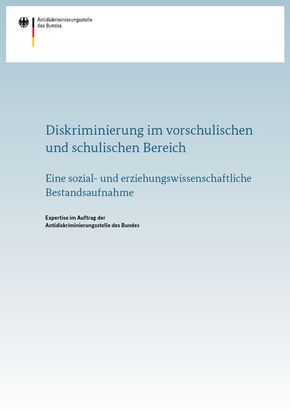Discrimination in the pre-school and school sector
Taking stock from the points of view of social and educational science
- Fact sheet on the research project -
Authors: Professor Dr Sven Jennessen, Professor Dr Nicole Kastirke, Professor Dr Jochem Kotthaus, published by the Federal Anti-Discrimination Agency (FADA) Year of publication: 2013
Brief overview
The expert study offers an overview of the state of the art of social science research regarding discrimination in the preschool and school sector in Germany. Forms, causes and the handling of discrimination in the educational sector are brought into the spotlight, with due regard for all dimensions mentioned in Section 1 of the General Equal Treatment Act, also the aspect of ‘social origin’.
Main results
Starting points
- Discrimination in and by the educational system is a real phenomenon which can be substantiated. The decisive ground for discrimination is the so-called social origin, but the discrimination may also be based on different characteristics set forth in the General Equal Treatment Act.
- Education is not only provided at schools, but also in the living environment and in the family. These environments may take influence on success or failure at school.
- Transitions in the education system, as e.g. from infant day care centres to elementary school or from elementary school to secondary schools, are decisive for the subsequent education and training biography. The currently applicable selection procedure leads to educational inequity.
Early childhood education / preschool sector
- Children of a so-called low social origin, from a migrant background and with disabilities – in particular those under three years of age - are underrepresented in infant day care centres. In this way, unfavourable starting positions (different family backgrounds and individual starting positions) cannot be compensated for sufficiently.
- Particularly the early child education in specialised institutions for children with disabilities may place these children at a disadvantage in their development opportunities. The same applies to cases where, due to the socio-spatial segregation, migrant children visit infant day care centres with a high proportion of children whose second language is German and/or who tend to have a low social capital from their families.
- The social structure of the staff employed in institutions of early childhood education is unfavourable: As most of the staff members in this sector are women, gender-specific approaches of early childhood education can be implemented to a merely limited extent.
- Direct interactional discrimination may – even as an unconscious process – lead to consequences already in infant day care centres.
Elementary school
- Stereotyped judgements and attributions, particularly on grounds of a person’s social or ethnic origin and/or language influence the decisions on repetition of a school year and transfers to special needs schools, the assessment of the need for support, but also the allocation of marks, and they have a negative impact on the transition to secondary schools.
- The risk of exclusion for pupils with special educational needs largely depends on the respective Federal Land. The parents’ wishes play a decisive role in the access to regular schools.
- The usual method of selection, applied in a rigid manner and not always valid, leads to a strong educational inequity. Misjudgements and misplacements are based on the – definitely doubtful – assumption that groups of pupils have to be homogenised and be selected in due time for specific educational pathways.
Secondary levels I and II
- At the secondary level I (and II), prejudicial effects and discrimination increase in the course of the education. The type of school visited, which largely depends on the ‘social origin’, becomes decisive for success at school.
- The risk of poverty as well as discrimination on grounds of ethnic origin and disadvantages in education can presuppose each other.
- The use of a mother tongue other than German at school may incur a risk of discrimination and be interpreted as a lack of willingness for integration.
- Gender-specific attributions and expectations at school can have a negative impact on girls (e.g. with regard to their choice of subjects and a future career aspiration), but also for boys (e.g. success at school) and may thus lead to discrimination.
Options for action
- In its gist, education should be considered and reconsidered once more and not merely be geared to the future employability of pupils (on the labour market). What is needed in this context, is a fundamental discussion about the role and the significance of schools.
- The origin and consolidation of discrimination and educational inequity in the education system should be disclosed systematically.
- Both, everyday interactional forms of discrimination, but also institutional discrimination in the educational sector should be brought into the spotlight to a larger extent.

